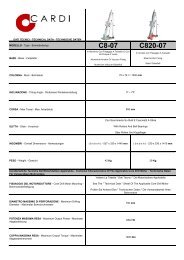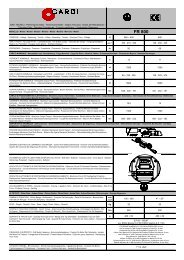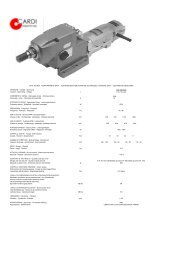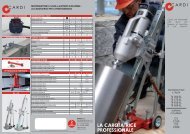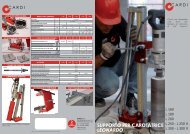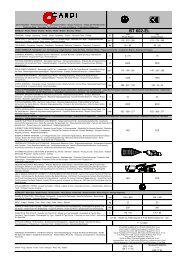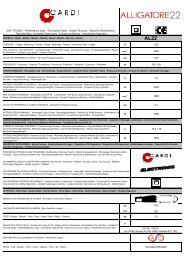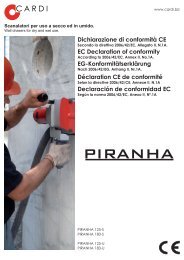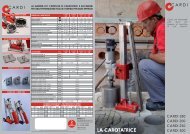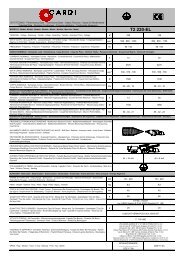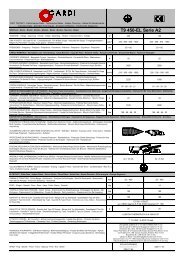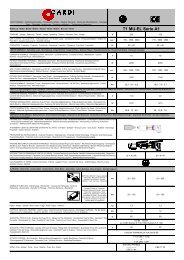Manule di Istruzioni ed uso - Cardi
Manule di Istruzioni ed uso - Cardi
Manule di Istruzioni ed uso - Cardi
Create successful ePaper yourself
Turn your PDF publications into a flip-book with our unique Google optimized e-Paper software.
1 Italiano<br />
La vostra sega murale portatile CARDI è un utensile elettrico progettato per eseguire tagli<br />
rettilinei su materiali lapidei, come cemento armato, mattoni, muratura, pietra naturale ecc.<br />
con un <strong>di</strong>sco <strong>di</strong>amantato saldato al laser.<br />
È assolutamente vietato utilizzare <strong>di</strong>schi dentati per sega circolare o altri <strong>di</strong>schi <strong>di</strong><br />
tipo <strong>di</strong>verso da quello prescritto per la sega murale CARDI (figura 10 e 11).<br />
Norme <strong>di</strong> sicurezza generale<br />
ATTENZIONE! Leggere tutte le istruzioni. La mancata<br />
ottemperanza a tutte le istruzioni sotto elencate può dare<br />
luogo a scosse elettriche, incen<strong>di</strong> e/o lesioni serie. Il termine<br />
"utensile elettrico" <strong>di</strong> tutte le avvertenze elencate qui sotto si<br />
riferisce agli utensili elettrici azionati me<strong>di</strong>ante collegamento<br />
alla rete (con cavo) o azionati a batteria (senza cavo).<br />
CONSERVARE QUESTE ISTRUZIONI<br />
1) Area <strong>di</strong> lavoro<br />
a) Tenere pulita e ben illuminata l'area <strong>di</strong> lavoro.<br />
Le aree ingombre e buie possono provocare<br />
incidenti.<br />
b) Non azionare utensili elettrici in atmosfere<br />
esplosive, ad esempio in presenza <strong>di</strong> liqui<strong>di</strong>,<br />
gas o polveri infiammabili. Gli utensili elettrici<br />
creano scintille che possono provocare<br />
l'accensione <strong>di</strong> polveri o fumi.<br />
c) Tenere i bambini e i passanti ad adeguata<br />
<strong>di</strong>stanza durante l’azionamento <strong>di</strong> un utensile<br />
elettrico. Le <strong>di</strong>strazioni possono far perdere il<br />
controllo dell'utensile.<br />
2) Sicurezza elettrica<br />
d) La spina dell'utensile elettrico deve<br />
corrispondere alla presa. Mai mo<strong>di</strong>ficare la<br />
spina in alcun modo. Non utilizzare spine<br />
adattatrici con utensili elettrici dotati <strong>di</strong> messa a<br />
terra (a massa). Spine non mo<strong>di</strong>ficate e prese<br />
corrispondenti riducono il rischio <strong>di</strong> scossa elettrica.<br />
e) Evitare il contatto del corpo con superfici<br />
messe a terra o a massa quali tubi, ra<strong>di</strong>atori,<br />
cucine e frigoriferi. Se il corpo è a terra o a<br />
massa, il rischio <strong>di</strong> scossa elettrica aumenta.<br />
f) Non esporre gli utensili elettrici alla pioggia e<br />
non utilizzarli in luoghi umi<strong>di</strong>. L'ingresso <strong>di</strong><br />
acqua in un utensile elettrico aumenta il rischio <strong>di</strong><br />
scossa elettrica.<br />
g) Non maltrattare il cavo. Non utilizzare mai il<br />
cavo per trasportare, tirare o scollegare dalla<br />
presa <strong>di</strong> rete l'utensile elettrico. Tenere il cavo<br />
<strong>di</strong>stante da calore, olio, bor<strong>di</strong> affilati o parti in<br />
movimento. Cavi danneggiati o attorcigliati<br />
aumentano il rischio <strong>di</strong> scossa elettrica.<br />
h) Quando si aziona un utensile elettrico<br />
all'esterno, usare un cavo <strong>di</strong> estensione<br />
(prolunga) adeguato per l'<strong>uso</strong> in esterni. L'<strong>uso</strong> <strong>di</strong><br />
un cavo adeguato riduce il rischio <strong>di</strong> scossa<br />
elettrica.<br />
3) Sicurezza personale<br />
a) Non <strong>di</strong>strarsi mai, controllare quello che si sta<br />
facendo e usare il buon senso quando si<br />
azionano utensili elettrici. Non azionare<br />
l'utensile quando si è stanchi o sotto l'influsso<br />
<strong>di</strong> droghe, alcol o me<strong>di</strong>cazioni. Un momento <strong>di</strong><br />
<strong>di</strong>sattenzione durante l'azionamento <strong>di</strong> utensili<br />
elettrici può dare luogo a serie lesioni personali.<br />
b) Usare attrezzature <strong>di</strong> sicurezza. Indossare<br />
sempre protezioni per gli occhi. L'<strong>uso</strong><br />
appropriato <strong>di</strong> attrezzature <strong>di</strong> sicurezza quali<br />
maschere anti-polvere, calzature <strong>di</strong> sicurezza<br />
antiscivolo, casco <strong>di</strong> sicurezza o protezioni per<br />
l'u<strong>di</strong>to riduce la possibilità <strong>di</strong> subire lesioni<br />
personali.<br />
c) Evitare le accensioni accidentali. Assicurarsi<br />
che l'interruttore sia in posizione <strong>di</strong> spento<br />
prima <strong>di</strong> collegare l'utensile alla rete elettrica.<br />
Trasportare utensili elettrici con il <strong>di</strong>to<br />
sull'interruttore o collegati in rete con l’interruttore in<br />
posizione <strong>di</strong> accensione può provocare incidenti.<br />
d) Rimuovere qualsiasi chiave <strong>di</strong> regolazione<br />
prima <strong>di</strong> accendere l'utensile elettrico. Una<br />
chiave lasciata attaccata a una parte rotante<br />
dell'utensile elettrico può provocare lesioni<br />
personali.<br />
e) Non sbilanciarsi. Mantenere sempre la<br />
posizione e l'equilibrio appropriati. Questo<br />
permette <strong>di</strong> controllare meglio l'utensile elettrico in<br />
situazioni impreviste.<br />
f) Vestirsi in modo appropriato. Non indossare<br />
vestiti larghi, collane o oggetti pendenti. Tenere<br />
capelli, indumenti e guanti <strong>di</strong>stanti dalle parti in<br />
movimento. Vestiti larghi, collane, oggetti pendenti<br />
o capelli lunghi possono impigliarsi nelle parti in<br />
movimento.<br />
g) Se sono previsti <strong>di</strong>spositivi da collegare ad<br />
impianti per l'estrazione e la raccolta <strong>di</strong> polvere,<br />
accertarsi che siano collegati e usati in maniera<br />
appropriata. L'<strong>uso</strong> <strong>di</strong> questi <strong>di</strong>spositivi può ridurre i<br />
rischi correlati alla polvere.<br />
h) Usare l'impugnatura ausiliaria fornita con<br />
l'utensile elettrico. Il mancato <strong>uso</strong><br />
dell'impugnatura ausiliaria può causare la per<strong>di</strong>ta <strong>di</strong><br />
controllo dell'utensile che può dare luogo a serie<br />
lesioni personali.<br />
4) Uso e manutenzione degli utensili elettrici<br />
a) Non forzare l'utensile elettrico. Usare l'utensile<br />
adatto per l'operazione da eseguire. L'utensile<br />
elettrico appropriato permette <strong>di</strong> eseguire il lavoro<br />
con maggiore efficienza e sicurezza senza essere<br />
costretti a superare i parametri d'<strong>uso</strong> <strong>di</strong> progetto.<br />
b) Non usare l'utensile elettrico se l'interruttore <strong>di</strong><br />
accensione o spegnimento non si aziona<br />
correttamente. Qualsiasi utensile elettrico che non<br />
può essere controllato con l’interruttore è<br />
pericoloso e deve essere sottoposto a riparazioni.<br />
c) Scollegare la spina dalla rete <strong>di</strong> alimentazione<br />
prima <strong>di</strong> effettuare qualsiasi regolazione,<br />
cambiare accessori o riporre gli utensili<br />
elettrici. Tale misura <strong>di</strong> sicurezza preventiva riduce<br />
il rischio <strong>di</strong> avvio accidentale dell’utensile elettrico.<br />
d) Riporre gli utensili elettrici inutilizzati fuori della<br />
portata dei bambini e non permetterne l'<strong>uso</strong> a<br />
persone inesperte o che non conoscano queste<br />
istruzioni. Gli utensili elettrici sono pericolosi se<br />
utilizzati da persone inesperte.<br />
e) Effettuare la manutenzione necessaria sugli<br />
utensili elettrici. Verificare il possibile errato<br />
allineamento o bloccaggio delle parti in<br />
movimento, la rottura delle parti e qualsiasi<br />
altra con<strong>di</strong>zione che possa influenzare il<br />
funzionamento degli utensili elettrici. Se è<br />
danneggiato, far riparare l'utensile elettrico prima <strong>di</strong><br />
utilizzarlo. Numerosi incidenti sono provocati<br />
proprio dal cattivo stato <strong>di</strong> manutenzione degli<br />
utensili elettrici.
Italiano 2<br />
f) Mantenere puliti e affilati gli strumenti <strong>di</strong> taglio.<br />
Strumenti <strong>di</strong> taglio in buone con<strong>di</strong>zioni <strong>di</strong><br />
manutenzione e con bor<strong>di</strong> <strong>di</strong> taglio affilati soffrono<br />
<strong>di</strong> blocchi con minore probabilità e sono più facili da<br />
controllare.<br />
g) Usare l'utensile elettrico, gli accessori e le<br />
punte ecc., in conformità con queste istruzioni<br />
e nel modo previsto per il tipo particolare <strong>di</strong><br />
utensile elettrico, tenendo conto delle<br />
con<strong>di</strong>zioni <strong>di</strong> lavorazione e dell'operazione da<br />
eseguire. L’<strong>uso</strong> dell’utensile elettrico per<br />
operazioni <strong>di</strong>verse da quelle previste può dare<br />
luogo a situazioni pericolose.<br />
5) Assistenza<br />
a) Far riparare l'utensile elettrico solo da tecnici<br />
qualificati e utilizzare soltanto ricambi identici.<br />
Questo garantisce la costante sicurezza<br />
dell’utensile elettrico.<br />
Ulteriori <strong>di</strong>sposizioni <strong>di</strong> sicurezza per seghe murali<br />
Indossare<br />
sempre<br />
occhiali<br />
protettivi<br />
Indossare<br />
calzature<br />
protettive<br />
Indossare<br />
guanti<br />
protettivi<br />
Indossare<br />
maschere<br />
antipolvere<br />
Indossare<br />
sempre<br />
protezioni<br />
per l’u<strong>di</strong>to<br />
<strong>Istruzioni</strong> da seguire prima della<br />
messa in funzione<br />
Leggere attentamente i dati riportati sulla<br />
targhetta della carotatrice e della sch<strong>ed</strong>a Dati<br />
tecnici fornita con il prodotto.<br />
Per le illustrazioni si faccia riferimento alle pagine iniziali <strong>di</strong><br />
questo manuale. Nel testo che segue le figure sono<br />
identificate da numeri mentre i singoli particolari, all'interno<br />
delle figure, sono identificati da lettere.<br />
Alimentazione elettrica<br />
Messa a terra<br />
• la vostra sega murale è dotata <strong>di</strong> collegamento a<br />
terra delle parti metalliche (messa a terra), in<br />
quanto è previsto l’<strong>uso</strong> con acqua;<br />
• assicurarsi quin<strong>di</strong> che anche la presa <strong>ed</strong> eventuali<br />
prolunghe o multiple a cui collegate il motoriduttore<br />
siano dotati <strong>di</strong> conduttore <strong>di</strong> terra e che l'impianto<br />
elettrico <strong>di</strong> alimentazione sia debitamente messo a<br />
terra<br />
Attenzione: questo requisito <strong>di</strong> sicurezza<br />
è <strong>di</strong> fondamentale importanza. In caso <strong>di</strong><br />
dubbio richi<strong>ed</strong>ere un controllo accurato<br />
dell'impianto da parte <strong>di</strong> personale<br />
professionalmente qualificato.<br />
Prolunghe<br />
• nel caso in cui il materiale da tagliare sia lontano da<br />
una presa <strong>di</strong> corrente possono essere utilizzati cavi<br />
<strong>di</strong> prolunga che devono essere <strong>di</strong> sezione adeguata<br />
e provvisti <strong>di</strong> conduttore <strong>di</strong> terra;<br />
• tali cavi <strong>di</strong> prolunga, costituiti da cavo, spina e<br />
presa, devono essere adatti all'<strong>uso</strong> esterno e<br />
preferibilmente in gomma e del tipo H07RN-F;<br />
• attenersi scrupolosamente alla tabella in figura 15<br />
<strong>di</strong> questo manuale per la scelta della sezione dei<br />
conduttori;<br />
• se si utilizza più <strong>di</strong> un cavo <strong>di</strong> prolunga accertarsi<br />
che ciascun cavo <strong>di</strong> prolunga abbia una sezione dei<br />
conduttori non inferiore a quanto in<strong>di</strong>cato nella<br />
tabella in relazione alla lunghezza totale;<br />
• limitare al minimo possibile la lunghezza delle<br />
prolunghe in quanto ogni prolunga provoca una<br />
caduta <strong>di</strong> tensione e peggiora il funzionamento<br />
della vostra sega murale.<br />
Preparazione della sega murale<br />
Per preparare la vostra sega murale al taglio, operare come<br />
in<strong>di</strong>cato nei punti successivi, accertandosi, prima, che la<br />
spina sia staccata dalla rete <strong>di</strong> alimentazione elettrica.<br />
a) avvitare l’impugnatura ausiliaria (B) in uno dei<br />
possibili fori filettati, nella posizione che risulti più<br />
comoda per la tipologia <strong>di</strong> lavoro che verrà<br />
effettuato. Si v<strong>ed</strong>a a riguardo la figura 1 e 2;<br />
b) fissare l’impugnatura principale (A), nella posizione<br />
che risulti più comoda per la tipologia <strong>di</strong> lavoro che<br />
verrà effettuato così come in<strong>di</strong>cato in figura 1 e 4;<br />
Attenzione: il mancato utilizzo delle<br />
impugnature può dar luogo alla per<strong>di</strong>ta <strong>di</strong><br />
controllo dell'utensile e a serie lesioni<br />
personali.<br />
c) collegare il tubo <strong>di</strong> adduzione dell'acqua alla<br />
valvola acquastop rappresentata in figura 1 con la<br />
lettera D;<br />
d) regolare e bloccare il sistema <strong>di</strong> regolazione della<br />
profon<strong>di</strong>tà <strong>di</strong> taglio, come rappresentato in figura 13<br />
F.<br />
PRCD: interruttore <strong>di</strong>fferenziale portatile<br />
montato sul cavo <strong>di</strong> alimentazione<br />
• la vostra sega murale è dotata <strong>di</strong> un interruttore<br />
<strong>di</strong>fferenziale (PRCD) montato sul cavo,<br />
rappresentato nella figura 7;<br />
• non utilizzare mai il prodotto senza il PRCD<br />
montato sul cavo;<br />
• prima <strong>di</strong> cominciare ad utilizzare il vostro prodotto<br />
verificare il corretto funzionamento del <strong>di</strong>spositivo<br />
PRCD: collegare la sega murale all'impianto <strong>di</strong><br />
alimentazione e quin<strong>di</strong> premere il tasto verde Reset<br />
(O). Questo provoca l’accensione una spia rossa<br />
(P) che segnala le <strong>di</strong>sponibilità <strong>di</strong> tensione.<br />
Azionare quin<strong>di</strong> il tasto blu Test (N), che verifica il<br />
funzionamento del <strong>di</strong>spositivo, che deve<br />
automaticamente scattare in posizione 0 (OFF),<br />
parallelamente a questo la spia rossa deve<br />
spegnersi;<br />
• se durante il lavoro l'interruttore <strong>di</strong>fferenziale<br />
dovesse scattare, interrompendo l'alimentazione,<br />
sospendere il taglio, posizionare l'interruttore della<br />
sega murale in posizione OFF e provv<strong>ed</strong>ere a<br />
ricercare <strong>ed</strong> eliminare la causa <strong>di</strong> <strong>di</strong>spersione<br />
ricorrendo alle prestazioni <strong>di</strong> un centro <strong>di</strong><br />
assistenza qualificato.<br />
Interruttore <strong>di</strong> comando<br />
L’utilizzo dell’interruttore <strong>di</strong> comando (figura 3 E) viene<br />
spiegato in figura 8.<br />
La vostra sega murale CARDI è dotata <strong>di</strong> un interruttore <strong>di</strong><br />
comando con <strong>di</strong>spositivo lock-off, che rende necessari due<br />
passaggi (prima I poi II) per mettere in funzione la<br />
macchina. Questo riduce notevolmente il rischio <strong>di</strong><br />
accensione accidentale della sega murale. È importante<br />
familiarizzare con il meccanismo <strong>di</strong> accensione<br />
dell’interruttore <strong>di</strong> comando.<br />
Attenzione: prestare attenzion al fatto che una<br />
volta posizionato l’interruttore su OFF, il <strong>di</strong>sco<br />
non si ferma imme<strong>di</strong>atamente.
3 Italiano<br />
Adduzione dell'acqua<br />
L’adduzione dell’acqua ha la funzione <strong>di</strong> eliminare i rischi<br />
legati alla produzione <strong>di</strong> polvere durante il taglio. Per questo<br />
è preferibile utilizzare la sega murale con l’adduzione<br />
dell’acqua. Nell’utilizzo a secco indossare apposite<br />
maschere antipolvere. Nel taglio con acqua, seguire queste<br />
in<strong>di</strong>cazioni:<br />
• utilizzare esclusivamente il tubo dell’acqua<br />
(rappresentato in figura 1) fornito con la macchina.<br />
Il tubo originale è dotato <strong>di</strong> un rubinetto (C) e <strong>di</strong> una<br />
valvola acquastop (D) <strong>di</strong> sicurezza;<br />
• l’acqua immessa deve avere una pressione<br />
inferiore a 4 bar;<br />
• l’acqua immessa deve essere pulita;<br />
• regolare, tramite il rubinetto (C), il flusso, in<br />
particolare facendo affluire la quantità minima <strong>di</strong><br />
acqua che permetta <strong>di</strong> abbattere le polveri<br />
generate;<br />
• impe<strong>di</strong>re che l’acqua entri in contatto con le parti<br />
elettriche della sega murale;<br />
• verificare l’integrità dei componenti <strong>di</strong> adduzione<br />
dell’acqua: il rubinetto (C), la valvola acquastop (D)<br />
il gomito <strong>di</strong> ingresso.<br />
Controlli e precauzioni per evitare danni<br />
alla struttura o ad impianti esistenti<br />
Prima <strong>di</strong> utilizzare la vostra sega murale assicurarsi presso il<br />
capo cantiere o il progettista che le operazioni <strong>di</strong> taglio:<br />
• non alterino le caratteristiche strutturali della<br />
costruzione;<br />
• non danneggino tubazioni dell'acqua o del gas o<br />
conduttori elettrici <strong>di</strong> ogni sorta.<br />
Scelta del tipo <strong>di</strong> <strong>di</strong>sco<br />
La vostra sega murale CARDI è progettata per tagliare<br />
materiali come cemento, cemento armato, mattoni,<br />
muratura, pietra naturale, ecc.. Per effettuare i tagli utilizzare<br />
esclusivamente <strong>di</strong>schi <strong>di</strong>amantati saldati al laser (figura 10 e<br />
11).<br />
Attenzione: è assolutamente vietato utilizzare<br />
<strong>di</strong>schi dentati per sega circolare o altri <strong>di</strong>schi <strong>di</strong><br />
tipo <strong>di</strong>verso da quello prescritto per la sega<br />
murale CARDI.<br />
Contattare il vostro <strong>di</strong>stributore per informazioni sul <strong>di</strong>sco da<br />
utilizzare secondo le vostre necessità operative. Il <strong>di</strong>sco,<br />
rappresentato in figura 1 H, deve avere le seguenti<br />
caratteristiche <strong>di</strong>mensionali:<br />
• <strong>di</strong>ametro massimo 400 mm;<br />
• <strong>di</strong>ametro del foro 25,4 mm (1 pollice). È possibile<br />
utilizzare <strong>di</strong>schi con foro <strong>di</strong> 30 mm utilizzando un<br />
apposito anello <strong>di</strong> riduzione;<br />
• spessore compreso tra 2 e 3 mm;<br />
• velocità <strong>di</strong> rotazione massima, in<strong>di</strong>cata dal<br />
produttore del <strong>di</strong>sco, superiore alla velocità <strong>di</strong><br />
rotazione massima dell'albero della sega murale<br />
CARDI, in<strong>di</strong>cata in targhetta dati (si v<strong>ed</strong>a l’esempio<br />
in figura 14 I).<br />
Usare solo <strong>di</strong>schi il cui <strong>di</strong>ametro, foro e spessore siano<br />
compatibili con il vostro modello <strong>di</strong> sega murale CARDI.<br />
Dischi con caratteristiche <strong>di</strong>mensionali non appropriate<br />
possono dare luogo a <strong>di</strong>sassamento, vibrazioni, rotazione<br />
irregolare e per<strong>di</strong>ta <strong>di</strong> controllo con possibile rischio <strong>di</strong> danni<br />
a cose o persone;<br />
Non utilizzare mai <strong>di</strong>schi danneggiati. Ispezionare il <strong>di</strong>sco<br />
prima <strong>di</strong> ogni <strong>uso</strong> per verificarne l'integrità.<br />
Montaggio e sostituzione del <strong>di</strong>sco<br />
Prima <strong>di</strong> montare o sostituire il <strong>di</strong>sco (figura 1 H),<br />
interrompere l'alimentazione elettrica, staccando la spina<br />
dalla rete <strong>di</strong> alimentazione. Per il montaggio e sostituzione<br />
del <strong>di</strong>sco fare riferimento alla figura 12. Operare seguendo<br />
queste in<strong>di</strong>cazioni:<br />
• sbloccare i sistemi <strong>di</strong> regolazione della profon<strong>di</strong>tà <strong>di</strong><br />
taglio per portare le <strong>di</strong>fese mobili alla minima<br />
apertura (12/A);<br />
• rimuovere il tappo <strong>di</strong> protezione (12/B);<br />
• svitare la vite <strong>di</strong> serraggio <strong>di</strong>sco (12/C) utilizzando<br />
la chiave a tubo fornita con la sega murale;<br />
• rimuovere la vite <strong>di</strong> serraggio <strong>di</strong>sco (12/D);<br />
• rimuovere la flangia <strong>di</strong> serraggio <strong>di</strong>sco (12/E);<br />
• utilizzare i sistemi <strong>di</strong> regolazione della profon<strong>di</strong>tà <strong>di</strong><br />
taglio per bloccare le <strong>di</strong>fese mobili alla massima<br />
apertura (12/F);<br />
• inserire o sostituire il <strong>di</strong>sco (12/G). Verificare che la<br />
<strong>di</strong>rezione delle frecce riportate sul <strong>di</strong>sco siano<br />
concor<strong>di</strong> con il senso <strong>di</strong> rotazione in<strong>di</strong>cato dalla<br />
freccia sul carter;<br />
• sbloccare i sistemi <strong>di</strong> regolazione della profon<strong>di</strong>tà <strong>di</strong><br />
taglio per portare le <strong>di</strong>fese mobili alla minima<br />
apertura (12/H);<br />
• montare la flangia <strong>di</strong> serraggio <strong>di</strong>sco (12/I);<br />
• inserire la vite <strong>di</strong> serraggio <strong>di</strong>sco (12/L);<br />
• avvitare la vite <strong>di</strong> serraggio <strong>di</strong>sco (12/M);<br />
• montare il tappo <strong>di</strong> protezione (12/N).<br />
Fissaggio del pezzo in lavorazione / Limiti<br />
<strong>di</strong>mensionali del pezzo in lavorazione<br />
• si presti particolare attenzione nel caso in cui si<br />
taglino blocchi <strong>di</strong> materiale che non siano parte<br />
integrante <strong>di</strong> una costruzione. In tal caso si<br />
provv<strong>ed</strong>a a fissarli rigidamente;<br />
• evitare assolutamente che, durante il taglio, tali<br />
blocchi possano muoversi o essere strappati dagli<br />
ancoraggi.<br />
Limitazioni alle con<strong>di</strong>zioni ambientali<br />
• non esporre la sega murale a pioggia, gran<strong>di</strong>ne o<br />
neve <strong>ed</strong> evitare in ogni caso che qualsiasi liquido<br />
entri in contatto con le parti elettriche della vostra<br />
sega murale;<br />
• non utilizzare la sega murale in atmosfere<br />
esplosive, per esempio in presenza <strong>di</strong> liqui<strong>di</strong>, gas o<br />
polveri infiammabili. La sega murale, in quanto<br />
utensile elettrico, crea scintille che possono<br />
provocare l'accensione <strong>di</strong> polveri o fumi.<br />
Taglio sopratesta<br />
Attenzione: la vostra sega murale NON è adatta<br />
alla realizzazione <strong>di</strong> taglio sopratesta (taglio<br />
soffitti).<br />
<strong>Istruzioni</strong> per il taglio<br />
Operare come segue<br />
Per effettuare il taglio, dopo aver preparato la sega murale<br />
come in<strong>di</strong>cato prec<strong>ed</strong>entemente nel paragrafo Preparazione<br />
della sega murale, seguire le seguenti in<strong>di</strong>cazioni:
Italiano 4<br />
Attenzione: non toccare con mani o con altre<br />
parti del corpo gli organi in movimento come<br />
corone, <strong>di</strong>schi o alberi.<br />
• aprire il rubinetto <strong>di</strong> adduzione dell’acqua, facendo<br />
affluire la quantità minima <strong>di</strong> acqua che permetta <strong>di</strong><br />
abbattere le polveri. Avviare la sega murale, <strong>ed</strong><br />
avvicinarsi alla superficie da tagliare con il <strong>di</strong>sco in<br />
movimento fino a sfiorarla, quin<strong>di</strong> aumentare la<br />
spinta verso il materiale da tagliare facendo<br />
penetrare il <strong>di</strong>sco finché i rulli non entrano in<br />
contatto con il materiale stesso. Far avanzare la<br />
sega murale per eseguire il taglio;<br />
• la vostra sega murale è adatta ad eseguire<br />
unicamente tagli rettilinei;<br />
• mantenere fisso l'orientamento del <strong>di</strong>sco durante il<br />
taglio. Questo evita il sovraccarico del motore<br />
causato dall’eccessivo attrito dei lati del <strong>di</strong>sco<br />
contro il materiale.<br />
Attenzione: nel caso in cui il <strong>di</strong>sco faccia presa<br />
sul lato del lembo <strong>di</strong> taglio potrebbe avere luogo<br />
l'effetto kickback: la sega murale potrebbe<br />
sobbalzare e tendere ad uscire dalla s<strong>ed</strong>e <strong>di</strong><br />
taglio con conseguente pericolo per l’incolumità<br />
dell’utente.<br />
• per la vostra incolumità mantenere sempre salda la<br />
presa, con entrambe le mani, sulle impugnature<br />
della sega murale, come rappresentato in figura 3 e<br />
4 e mantenersi sempre pronti a contrastare l’effetto<br />
kickback;<br />
• la presenza nell'area <strong>di</strong> taglio <strong>di</strong> materiali teneri<br />
quali legno, sughero, gomma, polistirolo, ecc. può<br />
creare <strong>di</strong>fficoltà nell'avanzamento del <strong>di</strong>sco<br />
costringendo talvolta a sospendere il taglio. In tal<br />
caso rimuovere le parti <strong>di</strong> materiale <strong>di</strong> ostacolo.<br />
Qualora questo non fosse possibile scegliere<br />
un'altra posizione per il vostro taglio;<br />
• concluse le operazioni <strong>di</strong> taglio, spegnere<br />
l'interruttore, attendere il completo arresto del <strong>di</strong>sco<br />
e rimuovere la sega murale dal taglio. Quin<strong>di</strong><br />
chiudere il rubinetto <strong>di</strong> adduzione dell’acqua;<br />
• a taglio effettuato, prestare attenzione al fatto che il<br />
<strong>di</strong>sco e l’area <strong>di</strong> taglio potrebbero essere cal<strong>di</strong> e<br />
causare ustioni.<br />
Elettronica<br />
La vostra sega murale è dotata dell'elettronica multifunzione<br />
CARDI che comprende un sistema <strong>di</strong> soft-start e una<br />
frizione elettronica:<br />
• il soft-start permette la partenza lenta, riduce il<br />
valore della corrente <strong>di</strong> spunto all'avviamento,<br />
facilita l’inizio del taglio con la messa in movimento<br />
graduale del <strong>di</strong>sco, evitando strappi all'operatore, e<br />
permette l'impiego della sega murale anche<br />
collegata a reti elettriche civili dotate <strong>di</strong> interruttori<br />
<strong>di</strong>fferenziali automatici ad altissima sensibilità;<br />
• la frizione elettronica controlla in ogni istante la<br />
corrente assorbita dalla sega murale, che è<br />
proporzionale allo sforzo richiesto al motore, e<br />
toglie potenza nel caso in cui il valore <strong>di</strong><br />
quest'ultima superi la soglia <strong>di</strong> sicurezza definita,<br />
evitando possibili danni alla sega murale. Non<br />
appena viene meno la causa all'origine del<br />
sovraccarico la frizione elettronica ridà<br />
automaticamente piena potenza al motore;<br />
• un intervento frequente della frizione elettronica è<br />
tipicamente causato da velocità <strong>di</strong> avanzamento<br />
eccessiva, <strong>di</strong>sassamento dell’asse <strong>di</strong> taglio o<br />
eccessiva profon<strong>di</strong>tà <strong>di</strong> taglio.<br />
Manutenzione - Assistenza-<br />
Garanzia<br />
Operazioni perio<strong>di</strong>che <strong>di</strong> pulizia,<br />
manutenzione e lubrificazione<br />
• al termine <strong>di</strong> ogni giornata <strong>di</strong> lavoro, dopo aver<br />
rimosso il <strong>di</strong>sco, soffiare un getto d'aria all'interno<br />
del motore, con motore in moto, per espellere<br />
eventuali impurità. Effettuare tale operazione<br />
indossando occhiali protettivi;<br />
• prima <strong>di</strong> eseguire le altre operazioni <strong>di</strong><br />
manutenzione, pulizia o lubrificazione assicurarsi<br />
che la sega murale sia <strong>di</strong>sconnessa dalla rete<br />
elettrica;<br />
• mantenere pulita <strong>ed</strong> asciutta la sega murale, in<br />
particolare le impugnature e le parti mobili;<br />
• non utilizzare solventi o altri prodotti chimici<br />
aggressivi per pulire la sega murale;<br />
• dopo l'<strong>uso</strong> riporre la sega murale in un luogo<br />
asciutto, sicuro <strong>ed</strong> inaccessibile ai bambini;<br />
• è consigliabile lubrificare giunture, sno<strong>di</strong> e cerniere<br />
del sistema <strong>di</strong> regolazione della profon<strong>di</strong>tà <strong>di</strong> taglio<br />
con un apposito spray idrorepellente;<br />
• il riduttore è lubrificato con olio e/o grasso adatti a<br />
qualsiasi temperatura ambientale. Non sono<br />
necessari controlli <strong>di</strong> livello o rabbocchi;<br />
• <strong>di</strong>sinserire sempre la spina dalla rete <strong>di</strong><br />
alimentazione quando ispezionate la macchina o<br />
sostituite l'utensile <strong>di</strong> taglio;<br />
• non staccare mai la spina dalla presa <strong>di</strong> corrente<br />
utilizzando il cavo <strong>di</strong> alimentazione;<br />
• ispezionare spesso il cavo <strong>di</strong> alimentazione <strong>ed</strong><br />
eventuali prolunghe, accertandosi che non vi siano<br />
danni quali tagli, abrasioni o conduttori in vista. In<br />
tal caso richi<strong>ed</strong>ere la sostituzione ad un centro<br />
assistenza CARDI;<br />
• non utilizzare la sega murale con parti danneggiate<br />
o con <strong>di</strong>fetti <strong>di</strong> funzionamento, in particolare nel<br />
caso in cui l'interruttore dovesse presentare <strong>di</strong>fetti<br />
nell'accensione o nello spegnimento. In questi casi<br />
provv<strong>ed</strong>ere a fare sostituire tali parti presso un<br />
centro <strong>di</strong> assistenza autorizzato.<br />
Assistenza<br />
• è necessario far controllare l'intera macchina dopo<br />
un periodo <strong>di</strong> 250 ore <strong>di</strong> lavoro presso il più vicino<br />
centro <strong>di</strong> assistenza autorizzato CARDI;<br />
• eventuali riparazioni o interventi <strong>di</strong> assistenza<br />
devono essere effettuati esclusivamente da un<br />
centro <strong>di</strong> assistenza autorizzato CARDI. Rivolgersi<br />
al vostro riven<strong>di</strong>tore per identificare il centro<br />
assistenza autorizzato più vicino.<br />
• il numero <strong>di</strong> matricola della vostra sega murale è<br />
stampigliato sulla macchina oppure in<strong>di</strong>cato sulla<br />
targhetta dati come nella figura 9;<br />
• richi<strong>ed</strong>ere sempre l'<strong>uso</strong> <strong>di</strong> parti <strong>di</strong> ricambio originali<br />
CARDI.<br />
Garanzia da parte del costruttore<br />
Questo prodotto è coperto da garanzia <strong>di</strong> 24 mesi della data<br />
<strong>di</strong> acquisto contro <strong>di</strong>fetti <strong>di</strong> materiale <strong>ed</strong> errori <strong>di</strong> progetto o<br />
fabbricazione. La garanzia copre il costo della sostituzione<br />
delle parti interessate, il costo delle operazioni <strong>di</strong><br />
sostituzione e il materiale <strong>di</strong> consumo, come olio e<br />
lubrificanti, se integri al momento della riparazione.
5 Italiano<br />
La garanzia non comprende la sostituzione <strong>di</strong>:<br />
• parti <strong>di</strong> prodotti che hanno subito interventi da parte<br />
<strong>di</strong> persone non autorizzate;<br />
• parti danneggiate per incuria, <strong>uso</strong> non adeguato o<br />
sovraccarico;<br />
• parti del prodotto al quale elementi <strong>di</strong> sicurezza<br />
siano stati rimossi o manomessi;<br />
• materiale <strong>di</strong> consumo esaurito, sostituito durante la<br />
riparazione.<br />
L'entrata dell'acqua nelle parti elettriche, la mancanza <strong>di</strong><br />
pulizia perio<strong>di</strong>ca, il danneggiamento delle parti filettate, del<br />
carter copri <strong>di</strong>sco o del corpo motore ecc., sono considerate<br />
incurie e fanno decadere il <strong>di</strong>ritto all'assistenza in garanzia.<br />
La durata delle parti <strong>di</strong> consumo non è definibile a priori,<br />
essendo in relazione al tempo <strong>di</strong> utilizzo del prodotto e<br />
all'intensità <strong>di</strong> lavoro. Esempi <strong>di</strong> parti <strong>di</strong> consumo sono:<br />
interruttori, spine e cavi, spazzole, collettore, <strong>di</strong>schi frizione,<br />
cuscinetti a rulli e a sfera non in bagno d’olio, anelli <strong>di</strong><br />
tenuta, sistemi <strong>di</strong> guida, filtri, ecc.<br />
Se durante la riparazione in garanzia vengono rilevati<br />
deterioramenti <strong>di</strong> parti <strong>di</strong> consumo, che possono influenzare<br />
la sicurezza o la funzionalità del prodotto, al cliente è<br />
chiesto <strong>di</strong> accettare l'onere del pagamento delle parti non<br />
soggette alla garanzia. Il rifiuto <strong>di</strong> ristabilire le con<strong>di</strong>zioni<br />
della sicurezza iniziale porta al rifiuto <strong>di</strong> ogni prestazione <strong>di</strong><br />
riparazione.<br />
La garanzia assicura la sostituzione gratuita delle parti<br />
riconosciute <strong>di</strong>fettose, per fabbricazione o per montaggio, <strong>di</strong><br />
prodotti resi ad un centro autorizzato se:<br />
• è fornita una prova della data <strong>di</strong> acquisto del<br />
prodotto. Sono ritenute prove valide i DDT<br />
(documenti <strong>di</strong> trasporto) e le fatture<br />
accompagnatorie;<br />
• è stata eseguita correttamente la manutenzione<br />
programmata ogni 250 ore <strong>di</strong> funzionamento con la<br />
sostituzione delle parti soggette a usura, come ad<br />
esempio le spazzole;<br />
• il prodotto non è stato manomesso da personale<br />
non adeguatamente istruito <strong>ed</strong> autorizzato da<br />
CARDI;<br />
• il prodotto è stato sempre usato in conformità a<br />
quanto in<strong>di</strong>cato in questo manuale <strong>di</strong> istruzioni;<br />
• le in<strong>di</strong>cazione <strong>di</strong> sicurezza riportate nel manuale <strong>di</strong><br />
istruzioni siano state osservate.<br />
CARDI non riconoscerà la riparazione in garanzia se:<br />
• il prodotto è stato manomesso da personale non<br />
autorizzato espressamente da CARDI;<br />
• i danni sono stati provocati da un utilizzo scorretto o<br />
da incuria. Ammaccature dovute a cadute o colpi<br />
ricevuti saranno considerate effetti <strong>di</strong> incuria;<br />
• i danni sono stati provocati da sovraccarico<br />
meccanico o elettrico;<br />
• i danni sono stati causati da ingresso dell’acqua o<br />
dei fanghi all'interno del prodotto.<br />
Nel periodo del garanzia, in alcuni casi, come nel caso in cui<br />
i tecnici autorizzati CARDI ritengano la riparazione troppo<br />
onerosa, è prevista la sostituzione gratuita del prodotto. La<br />
sostituzione in garanzia del prodotto viene garantita, inoltre,<br />
dopo due tentativi infruttuosi <strong>di</strong> riparazione e dopo un<br />
colloquio con i responsabili <strong>di</strong> un centro assistenza CARDI.<br />
In caso <strong>di</strong> sostituzione del prodotto viene normalmente<br />
addebitato l’ammontare corrispondente alla normale usura<br />
delle parti del prodotto sostituito.<br />
Elenco delle parti sostituibili dall'utente<br />
Nessuna parte del vostro utensile elettrico CARDI è<br />
sostituibile se non rivolgendosi ad un riparatore autorizzato<br />
CARDI.<br />
Centri <strong>di</strong> assistenza CARDI - Elenco<br />
in<strong>di</strong>rizzi<br />
Per l'elenco dei centri <strong>di</strong> assistenza rivolgersi al riven<strong>di</strong>tore.<br />
Elenco dei contenuti della<br />
confezione<br />
Fare riferimento alla Distinta Ricambi, specifica per il vostro<br />
modello, contenuta nella confezione insieme a questo<br />
manuale.<br />
ATTENZIONE:<br />
IL COSTRUTTORE DECLINA OGNI RESPONSABILITA'<br />
IN CASO DI DANNI A PERSONE, ANIMALI O COSE<br />
PROVOCATI DALLA MANCATA OSSERVANZA<br />
DELLE NORME DI SICUREZZA E D'USO SOPRA ELENCATE<br />
Prodotti giunti a fine vita.<br />
Il simbolo a sinistra, che compare sull'etichetta del vostro prodotto CARDI o sulla sua confezione, in<strong>di</strong>ca che il prodotto non può<br />
essere smaltito come rifiuto domestico al termine della sua vita. In base alla <strong>di</strong>rettiva europea 2002/96/EC, esso deve essere<br />
consegnato ad un punto <strong>di</strong> raccolta adatto per il riciclo <strong>di</strong> apparecchi elettrici o elettronici.<br />
È essenziale che questo prodotto venga riciclato o smaltito correttamente. In questa maniera si aiuta a prevenire potenziali<br />
conseguenze negative per l’ambiente e per la salute delle persone. Per informazioni dettagliate su cosa fare quando il prodotto non<br />
è più funzionante e non è più riparabile, vi preghiamo <strong>di</strong> contattare il riven<strong>di</strong>tore da cui avete acquistato il prodotto.<br />
Questo prodotto è stato immesso nuovo sul mercato dopo il 13 agosto 2005.<br />
Questo manuale è soggetto a mo<strong>di</strong>fiche senza preavviso.
English 6<br />
Your CARDI hand-held wall saw is a power tool design<strong>ed</strong> to make straight cuts in stonelike<br />
materials like reinforc<strong>ed</strong> concrete, bricks, masonry, natural stone, using laser-weld<strong>ed</strong><br />
<strong>di</strong>amond blades only.<br />
Warning: Do NOT use circular saw blades or other kinds of blades not laserweld<strong>ed</strong>.<br />
Failure to follow this warning may result in serious personal injury. See<br />
figure 10 and 11.<br />
General safety Rules<br />
WARNING! Read all instructions. Failure to follow all<br />
instructions list<strong>ed</strong> below may result in electric shock, fire<br />
and/or serious injury. The term "power tool" in all of the<br />
warnings list<strong>ed</strong> below refers to your mains operat<strong>ed</strong> (cord<strong>ed</strong>)<br />
power tool or battery operat<strong>ed</strong> (cordless) powertool.<br />
SAVE THESE INSTRUCTIONS<br />
1) Work area<br />
a) Keep working area clean and well lit. Clutter<strong>ed</strong><br />
and dark areas invite accidents.<br />
b) Do not operate power tools in explosive<br />
atmospheres, such as in the presence of<br />
flammable liquids, gases or dust. Power tools<br />
create sparks which may ignite the dust or fumes.<br />
c) Keep children and bystanders away while<br />
operating a power tool. Distractions can cause<br />
you to lose control.<br />
2) Electrical safety<br />
a) Power tool plugs must match the outlet. Never<br />
mo<strong>di</strong>fy the plug in any way. Do not use any<br />
adapter plugs with earth<strong>ed</strong> (ground<strong>ed</strong>) power<br />
tools. Unmo<strong>di</strong>fi<strong>ed</strong> plugs and matching outlets will<br />
r<strong>ed</strong>uce risk of electric shock.<br />
b) Avoid body contact with earth<strong>ed</strong> or ground<strong>ed</strong><br />
surfaces such as pipes, ra<strong>di</strong>ators, ranges and<br />
refrigerators. There is an increas<strong>ed</strong> risk of electric<br />
shock if your body is earth<strong>ed</strong> or ground<strong>ed</strong>.<br />
c) Do not expose power tools to rain or wet<br />
con<strong>di</strong>tions. Water entering a power tool will<br />
increase the risk of electric shock.<br />
d) Do not abuse the cord. Never use the cord for<br />
carrying, pulling or unplugging the power tool.<br />
Keep cord away from heat, oil, sharp <strong>ed</strong>ges or<br />
moving parts. Damag<strong>ed</strong> or entangl<strong>ed</strong> cords<br />
increase the risk of electric shock.<br />
e) When operating a power tool outdoors, use an<br />
extension cord suitable for outdoor use. Use of<br />
a cord suitable for outdoor use r<strong>ed</strong>uces the risk of<br />
electric shock.<br />
3) Personal safety<br />
a) Stay alert, watch what you are doing and use<br />
common sense when operating a power tool.<br />
Do not use a power tool while you are tir<strong>ed</strong> or<br />
under the influence of drugs, alcohol or<br />
me<strong>di</strong>cation. A moment of inattention while<br />
operating power tools may result in serious<br />
personal injury.<br />
b) Use safety equipments: always wear eye<br />
protection. Safety equipment such as dust mask,<br />
non-skid safety shoes, hard hat, or hearing<br />
protection us<strong>ed</strong> for appropriate con<strong>di</strong>tions will<br />
r<strong>ed</strong>uce personal injuries.<br />
c) Avoid accidental starting. Ensure the switch is<br />
in the off position before plugging in. Carrying<br />
power tools with your finger on the switch or<br />
plugging in power tools that have the switch on<br />
invites accidents.<br />
d) Remove any adjusting key or wrench before<br />
turning the power tool on. A wrench or a key left<br />
attach<strong>ed</strong> to a rotating part of the power tool may<br />
result in personal injury.<br />
e) Do not overreach. Keep proper footing and<br />
balance at all times. This enables better control of<br />
the power tool in unexpect<strong>ed</strong> situations.<br />
f) Dress properly. Do not wear loose clothing or<br />
jewellery. Keep your hair, clothing and gloves<br />
away from moving parts. Loose clothes, jewellery<br />
and long hair can be caught in moving parts.<br />
g) If devices are provid<strong>ed</strong> for the connection of<br />
dust extraction and collection facilities, ensure<br />
these are connect<strong>ed</strong> and properly us<strong>ed</strong>. Use of<br />
these devices can r<strong>ed</strong>uce dust relat<strong>ed</strong> hazards.<br />
h) Use auxiliary handles suppli<strong>ed</strong> with the tool.<br />
Loss of control can cause personal injury.<br />
4) Power tool use and care<br />
a) Do not force the power tool. Use the correct<br />
power tool for your application. The correct<br />
power tool will do the job better and safer at the<br />
rate for which it was design<strong>ed</strong>.<br />
b) Do not use the power tool if the switch does not<br />
turn it on and off. Any power tool that cannot be<br />
controll<strong>ed</strong> with the switch is dangerous and must<br />
be repair<strong>ed</strong>.<br />
c) Disconnect the plug from the power source<br />
before making any adjustments, changing<br />
accessories, or storing power tools. Such<br />
preventive safety measures r<strong>ed</strong>uce the risk of<br />
starting the power tool accidentally.<br />
d) Store idle power tools out of the reach of<br />
children and do not allow persons unfamiliar<br />
with the power tool or these instructions to<br />
operate the power tool. Power tools are<br />
dangerous in the hands of untrain<strong>ed</strong> users.<br />
e) Maintain power tools. Check for misalignment<br />
or bin<strong>di</strong>ng of moving parts, breakage of parts<br />
and any other con<strong>di</strong>tion that may affect the<br />
power tools operation. lf damag<strong>ed</strong>, have the<br />
power tool repair<strong>ed</strong> before use. Many accidents are<br />
caus<strong>ed</strong> by poorly maintain<strong>ed</strong> power tools.<br />
f) Keep cutting tools sharp and clean. Properly<br />
maintain<strong>ed</strong> cutting tools with sharp cutting <strong>ed</strong>ges<br />
are less likely to bind and are easier to control.<br />
g) Use the power tool, accessories and tool bits<br />
etc., in accordance with these instructions and<br />
in the manner intend<strong>ed</strong> for the particular type of<br />
power tool, taking into account the working<br />
con<strong>di</strong>tions and the work to be perform<strong>ed</strong>. Use of<br />
the power tool for operations <strong>di</strong>fferent from<br />
intend<strong>ed</strong> could result in a hazardous situation.<br />
5) Service<br />
a) Have your power tool servic<strong>ed</strong> by a qualifi<strong>ed</strong><br />
repair person using only identical replacement<br />
parts. This will ensure that the safety of the power<br />
tool is maintain<strong>ed</strong>.
7 English<br />
Ad<strong>di</strong>tional safety rules for wall saws<br />
Always<br />
wear safety<br />
goggles<br />
Always<br />
wear safety<br />
shoes<br />
Always<br />
wear<br />
safety<br />
gloves<br />
Always<br />
wear dust<br />
mask<br />
Instructions before use<br />
Always wear<br />
ear<br />
protection<br />
Read carefully the data report<strong>ed</strong> on the data plate<br />
of your core drill and on the Technical Data sheet<br />
that you will find in the package together with<br />
your product.<br />
In the following text, figures are identifi<strong>ed</strong> by numbers,<br />
details inside the figures by letters. Figures are depict<strong>ed</strong> on<br />
the first pages of this user manual.<br />
Power supply<br />
a) Earth (Ground)<br />
• since your hand-held saw operates with water, its<br />
metallic parts are connect<strong>ed</strong> to the earth;<br />
• make sure that socket and possible extension cords<br />
and multiple sockets have the earth connection and<br />
that your electrical system is properly connect<strong>ed</strong> to<br />
the earth.<br />
Warning: for your safety, it is important that<br />
the whole system (electrical system, extension<br />
cords, sockets etc.) is connect<strong>ed</strong> to the earth.<br />
If you are not sure, ask a qualifi<strong>ed</strong> electrician<br />
for a check.<br />
b) Extension cords<br />
• when you have to operate with your saw far from an<br />
electrical outlet, you can use an extension cord. If<br />
you use it, make sure that the section of the cord is<br />
suitable and that the cord is provid<strong>ed</strong> with ground<br />
conductor;<br />
• the extension cord (made up of cable, plug and<br />
socket) must be suitable for outdoor use. It is better<br />
if the cord is made of rubber and it is H07RN-F;<br />
• follow the chart shown in figure 15 on this manual<br />
for the choice of the right section of the conductors;<br />
• if you use more than one extension cord make sure<br />
that every cable in each extension cord has a<br />
section not lower than the value shown on the chart<br />
in figure 15, considering the total length of the<br />
extension cords;<br />
• remember that the more an extension cord is long<br />
the more the voltage drop is high and the worse is<br />
the operation of your saw. Do not use extension<br />
cords if you have to operate too far from the<br />
electrical socket.<br />
Preliminary operations<br />
In order to prepare your wall saw to operate, follow these<br />
steps. Before procee<strong>di</strong>ng with preparation make sure that<br />
the plug is <strong>di</strong>sconnect<strong>ed</strong> from the power supply.<br />
a) screw the auxiliary handle (B) in one in the more<br />
comfortable position accor<strong>di</strong>ng to the kind of cut you<br />
are going to perform. See figure 1 e 2;<br />
b) fix the main handle (A) in the more comfortable<br />
position for the application as shown in figure 1 and<br />
4;<br />
Warning: not using auxiliary and main handles<br />
can result in loss of control of your saw and<br />
serious personal injury.<br />
c) connect the quick hose connector (figure 1 D) to a<br />
proper water supply, keep the valve C close till you<br />
start to cut;<br />
d) set and fix the cutting-depth setting system (figure<br />
13 F) accor<strong>di</strong>ng with the desir<strong>ed</strong> cutting-depth;<br />
PRCD: portable residual current device<br />
• your wall saw is equipp<strong>ed</strong> with a safety portable<br />
residual current device (PRCD) assembl<strong>ed</strong> on the<br />
cord. This device is shown in figure 7;<br />
• never use the wall saw without PRCD;<br />
• before starting to operate, make sure the PRCD<br />
works properly. In order to do so, plug the wall saw<br />
in and press the green button Reset (O): a r<strong>ed</strong> l<strong>ed</strong><br />
will light up (P) showing that electricity is available<br />
toward the wall saw. Than press the blue button<br />
Test (N) that tests if the device works properly.<br />
When you press it the circuit breaker inside the<br />
PRCD should cut the power off lea<strong>di</strong>ng the switch<br />
automatically to go to the off position and the r<strong>ed</strong><br />
l<strong>ed</strong> to go off;<br />
• if, when cutting, the PRCD cuts the power: stop<br />
working, set the switch on OFF position and bring<br />
your chain saw to an authoriz<strong>ed</strong> service centre in<br />
order to remove the causes of the electrical<br />
<strong>di</strong>ssipation.<br />
ON/OFF switch<br />
See figure 8 in order to understand how to use the switch<br />
(figure 2 E).<br />
Your switch is equipp<strong>ed</strong> with a safety lock device. With this<br />
device you can switch on the motor only if you follow first<br />
step I and than step II, as shown in figure 8. This prevents<br />
the hand saw from starting accidentally.<br />
Caution: after switching off, the machine will<br />
not be idle imme<strong>di</strong>ately.<br />
Connection to a water supply<br />
Wet cutting r<strong>ed</strong>uces risks connect<strong>ed</strong> with dust sprea<strong>di</strong>ng.<br />
We recommend to use your wall saw in wet mode. If you<br />
want to cut without water wear a proper dust mask to protect<br />
yourself from dust. In wet cutting:<br />
• use only the water hose (figure 1) provid<strong>ed</strong> with<br />
your wall saw. The water hose includes also a valve<br />
(C) and a quick hose connector (D);<br />
• the maximum pressure of incoming water must be 4<br />
bar;<br />
• use just clean water;<br />
• your saw ne<strong>ed</strong>s a small amount of water: when<br />
operating, let just the minimum amount of water<br />
flow in;<br />
• prevent water from entering the motor or other<br />
electrical components;<br />
• check at regular intervals that none of the water<br />
system components are damag<strong>ed</strong>. Check in<br />
particular the valve (C), the quick hose connector<br />
(D) and the pipe.
English 8<br />
Checks and precautions to avoid<br />
structural damages and damages to the<br />
plant<br />
Before starting any cutting activity, talk with the construction<br />
manager or the planner in order to make sure that the cut<br />
doesn’t:<br />
• make any damage to the structure of the buil<strong>di</strong>ng<br />
and doesn’t change the structural characteristics of<br />
the construction;<br />
• damage any water or gas pipeline or any electric<br />
mains.<br />
Blade choice<br />
Your Car<strong>di</strong> wall saw has been design<strong>ed</strong> to cut buil<strong>di</strong>ng<br />
materials such as concrete, reinforc<strong>ed</strong> concrete, bricks,<br />
masonry, natural stones, tiles etc, using laser weld<strong>ed</strong><br />
<strong>di</strong>amond blades (figure 10 and 11).<br />
Warning: Do NOT use circular saw blades or<br />
other kind of blades not laser-weld<strong>ed</strong>. Failure to<br />
follow this warning may result in serious personal<br />
injury. See figure 10 and 11.<br />
Ask your dealer about the best blade for your application.<br />
The blade must have:<br />
a) maximum <strong>di</strong>ameter: 400 mm;<br />
b) arbor hole <strong>di</strong>ameter 25,4 mm (1 inch). You can use<br />
a blade with a 30 mm hole using a proper adapter;<br />
c) thickness between 2 and 3 mm;<br />
d) maximum rotating spe<strong>ed</strong>, given by the blade<br />
manufacturer, higher than the maximum rotating<br />
spe<strong>ed</strong> of the arbor, shown on the data plate (see<br />
figure 14 I).<br />
Use blades with <strong>di</strong>ameter, arbor hole and rotating spe<strong>ed</strong><br />
compatible with your specific hand saw model. Use of<br />
blades with inappropriate <strong>di</strong>mensions can result in<br />
misalignment, vibrations, irregular rotation and loss of<br />
control causing serious injury.<br />
Check the blade before use. Do not use damag<strong>ed</strong> blades.<br />
Blade mounting and replacement<br />
Before mounting or replacing the blade (figure 1 H) make<br />
sure the wall saw is unplugg<strong>ed</strong>. For blade mounting or<br />
replacement, follow these <strong>di</strong>rections, referring to figure 12:<br />
• unlock the cutting-depth setting system and move it<br />
till the minimum cutting-depth as shown in figure<br />
12/A;<br />
• remove the rubber stopper (12/B);<br />
• unscrew the blade-tightening screw (12/C), using<br />
the tubular spanner provid<strong>ed</strong> with your wall saw;<br />
• remove the blade-tightening screw (12/D);<br />
• remove the flange (12/E);<br />
• set the cutting depth setting system to the<br />
maximum cutting depth as shown in figure 12/F;<br />
• insert the new blade or replace the old one (12/G).<br />
Make sure the arrow on the blade agrees with<br />
arrow on the guard;<br />
• move the cutting depth setting system till the<br />
minimum cutting depth as shown in figure 12/H;<br />
• assemble the flange (10/I);<br />
• insert the blade-tightening screw (12/L);<br />
• tight the blade-tightening screw (12/M) using the<br />
tubular spanner provid<strong>ed</strong> with your wall saw;<br />
• assemble the rubber cork (12/N).<br />
Fastening the work piece and size of the<br />
work piece<br />
• if the work object is a block and not part of a<br />
structure, fasten it in order to prevent its movement;<br />
• prevent the work piece from shifting, moving or<br />
falling when you are cutting.<br />
Environmental con<strong>di</strong>tions<br />
• do not expose the wall saw to rain, ice or snow;<br />
• prevent water or any other liquid from coming into<br />
contact with the electric parts of your machine;<br />
• do not use the wall saw in explosive atmospheres,<br />
for instance inflammable liquids, gas or dust. The<br />
electric wall saw produces sparks which can ignite<br />
dust or smoke.<br />
Overhead cutting (ceiling cutting)<br />
Warning: your wall saw is NOT intend<strong>ed</strong> to<br />
perform overhead cutting (upward).<br />
Operating Instructions<br />
After having follow<strong>ed</strong> the instructions given in the previous<br />
Preliminary operations paragraph, follow these <strong>di</strong>rections in<br />
order to perform the cut.<br />
Warning: do not touch any moving parts of<br />
your wall saw, in particular the blade, when<br />
operating.<br />
• open the valve C your wall saw, letting in just the<br />
minimum amount of water to remove dust. Switch<br />
the motor on and move closer to the workpiece.<br />
When the blade touches the surface, push the wall<br />
saw toward the workpiece and let the blade go<br />
inside the material till you reach the desir<strong>ed</strong> cutting<br />
depth and the rollers touch the workpiece. Than pull<br />
to cut;<br />
• your wall saw is intend<strong>ed</strong> to perform just straight<br />
cuts;<br />
• avoid friction between the blade-side and the<br />
workpiece: move the wall saw just forward avoi<strong>di</strong>ng<br />
side movement of the blade. The friction can<br />
overload the motor;<br />
Warning: when cutting, the blade can bind in<br />
the cut causing the saw to kickback. In this case<br />
the saw tends to move toward or away from the<br />
operator. The kickback is dangerous for the<br />
operator and it can cause serious injury.<br />
• use the handles and hold your wall saw firmly with<br />
both hands (see figure 5 and 6) and be ready to<br />
resist to a possible kickback;<br />
• cutting materials containing wood, cork, rubber,<br />
foam polystyrene can result in problems moving<br />
forward the machine. If you have this kind of<br />
problems, stop cutting and remove all materials<br />
list<strong>ed</strong> before and proce<strong>ed</strong> with cutting operations. If<br />
you cannot remove these materials, stop cutting<br />
and cut in another position;<br />
• when you complete the cut, trigger the switch off<br />
and wait till the blade comes to a complete stop.<br />
Then pull the wall saw out of the cut and close the<br />
water valve (C). Watch out! The blade and the<br />
cutting area can be very hot ad cause severe<br />
burns.
9 English<br />
Electronic devices<br />
Your wall saw is equipp<strong>ed</strong> with a CARDI multifunction<br />
electronic device that includes a soft-start and an electronic<br />
clutch:<br />
• the soft-start allows the motor to start gradually,<br />
r<strong>ed</strong>ucing peak current that occurs when you switch<br />
the motor on, helps you when you begin cutting,<br />
allowing gradual blade rotation and avoi<strong>di</strong>ng jerks<br />
at the operator’s arm. It allows you to use your<br />
hand saw connect<strong>ed</strong> to household electrical outlet.<br />
• the electronic clutch cuts off power to the motor in<br />
case of excessive overload, increasing the operator<br />
safety and preventing damage to the motor. When<br />
the overload is over, the device gives back power to<br />
the motor that begins working again;<br />
• if the electronic clutch operates frequently means<br />
that the hand saw is not us<strong>ed</strong> properly. Possible<br />
causes can be a not suitable forward spe<strong>ed</strong>, an<br />
excessive friction between the blade-side and the<br />
material, excessive cutting depth.<br />
Maintenance - Service - Warranty<br />
Perio<strong>di</strong>c maintenance<br />
• at the end of the work, after having remov<strong>ed</strong> the<br />
blade, blow compress<strong>ed</strong> air inside the rotating<br />
motor in order to remove dust and powder. Do this<br />
operation wearing protective goggles;<br />
• before starting any other cleaning, maintenance or<br />
lubrication operation make sure that the wall saw is<br />
unplugg<strong>ed</strong>;<br />
• keep your wall saw clean and dry, in particular its<br />
handles and its moving parts;<br />
• never use solvents or other harsh chemicals for<br />
cleaning your wall saw;<br />
• after use put your wall saw in a dry, safe and<br />
inaccessible to children place;<br />
• we recommend to lubricate hinges, joints and pivots<br />
belonging to cutting-depth setting system with a<br />
suitable water-repellent spray<br />
• gears are lubricat<strong>ed</strong> by lubricating oil and grease<br />
which are suit<strong>ed</strong> for any external temperature. You<br />
don’t have to check the oil level or to fill it up.<br />
• always unplug the wall saw during check or blade<br />
replacement;<br />
• never unplug the wall saw by pulling the cord;<br />
• inspect often the fee<strong>di</strong>ng cable and extension<br />
cords, making sure that they don’t have any<br />
damage like cuts, abrasions or live conductors. If<br />
you find a damage, ask to a CARDI authoriz<strong>ed</strong><br />
service centre for replacement;<br />
• do not use the wall saw with damag<strong>ed</strong> components<br />
or with malfunctions, in particular when the switch<br />
doesn’t work properly. In these cases, ask a CARDI<br />
authoriz<strong>ed</strong> service centre for replacement.<br />
Service<br />
• after 250 hours work<strong>ed</strong>, bring your wall saw to a<br />
CARDI authoriz<strong>ed</strong> service centre for perio<strong>di</strong>cal<br />
check;<br />
• any repairing on your wall saw must be carri<strong>ed</strong> out<br />
by CARDI authoriz<strong>ed</strong> service personnel only. Ask<br />
your dealer for the list of the CARDI authoriz<strong>ed</strong><br />
service centres;<br />
• your machine's serial number is stamp<strong>ed</strong> on the<br />
machine or print<strong>ed</strong> on the data plate as shown in<br />
figure 9;<br />
Use original CARDI spare parts only.<br />
Warranty<br />
Your product is under CARDI warranty for 24 months,<br />
starting from the date of purchase. This warranty is against<br />
faulty workmanship, flaws material and design problems.<br />
The warranty covers free components replacement,<br />
manpower ne<strong>ed</strong><strong>ed</strong> for replacement and wearing materials<br />
such as oil and lubricants if intact before the repairing<br />
operation. The warranty doesn't cover the replacement of:<br />
• components of the product replac<strong>ed</strong> or mo<strong>di</strong>fi<strong>ed</strong> by<br />
people not authoriz<strong>ed</strong> by CARDI;<br />
• components damag<strong>ed</strong> by carelessness, not<br />
suitable use or overload<strong>ed</strong>;<br />
• components of products from which safety devices<br />
have been remov<strong>ed</strong>;<br />
• worn wearing parts replac<strong>ed</strong> during repair.<br />
This warranty does not apply to products that have been<br />
damag<strong>ed</strong> by carelessness like water entering the wall saw,<br />
lack of perio<strong>di</strong>c cleaning and maintenance, damage of the<br />
thread<strong>ed</strong> components or the spindle etc.<br />
The life of wearing parts is variable depen<strong>di</strong>ng on using time<br />
and the kind of job they are us<strong>ed</strong> for. Examples of wearing<br />
parts are: cables, switches and plugs, brushes,<br />
commutators, clutch plates, ball and roller bearing not in oil,<br />
sealing rings, transmission spindles, filters, etc.<br />
If during repairing under warranty, a wearing part is worn<br />
and this can affect the safety and the operation of your<br />
product, the customer is ask<strong>ed</strong> to pay for the replacement of<br />
these components not under warranty. If the customer<br />
refuses this, no repairing operation will be carri<strong>ed</strong> out.<br />
The warranty covers free replacement of components which<br />
are defective due to wrong manufacturing or assembly, if the<br />
product is brought to an authoriz<strong>ed</strong> service centre and if:<br />
• the product is together with a purchasing document<br />
stating when the product has been purchas<strong>ed</strong>.<br />
Valid purchasing documents are invoices or<br />
delivery certificates;<br />
• maintenance operations have been carri<strong>ed</strong> out<br />
every 250 working hours, replacing the worn<br />
wearing parts;<br />
• no unauthoriz<strong>ed</strong> people have operat<strong>ed</strong> on the<br />
product;<br />
• the product has not been misus<strong>ed</strong> and it has been<br />
us<strong>ed</strong> accor<strong>di</strong>ngly with the <strong>di</strong>rections given in this<br />
user manual;<br />
• all safety <strong>di</strong>rections have been follow<strong>ed</strong>.<br />
Your CARDI product is not under warranty if:<br />
• the product has been servic<strong>ed</strong> by people not<br />
authoriz<strong>ed</strong> by CARDI.<br />
• damages are due to incorrect use and/or<br />
carelessness. Dents due to drops or strokes will be<br />
consider<strong>ed</strong> evidence of carelessness;<br />
• damages have been caus<strong>ed</strong> by mechanical or<br />
electrical overload;<br />
• damages have been caus<strong>ed</strong> by water, mud or any<br />
other liquid entering the product.<br />
When your product is under warranty, in some cases, for<br />
example when CARDI authoriz<strong>ed</strong> service personnel think<br />
the repairing is too expensive to be carri<strong>ed</strong> out, the free<br />
substitution of the product is possible. In ad<strong>di</strong>tion, the<br />
substitution under warranty is provid<strong>ed</strong> after two fruitless<br />
reparation attempts and after the authorization of a CARDI<br />
service manager. In case of substitution, the customer is,<br />
usually, request<strong>ed</strong> to pay for the worn wearing parts of the<br />
product that has been replac<strong>ed</strong>.
English 10<br />
User-replaceable components<br />
No components of your CARDI product can be replac<strong>ed</strong> by<br />
the user. Replacement must be carri<strong>ed</strong> out by CARDI<br />
authoriz<strong>ed</strong> personnel only.<br />
CARDI service centres - Address list:<br />
Ask your dealer for a CARDI service centres address list.<br />
Package Contents<br />
For the list of contents refer to the Spare Parts List, specific<br />
for your model, locat<strong>ed</strong> in the package together with this<br />
manual.<br />
WARNING:<br />
THE MANUFACTURER DECLINES ALL RESPONSABILITY<br />
IN CASE OF NO RESPECT OF THE ABOVE WRITTEN<br />
"SAFETY AND OPERATING INSTRUCTIONS".<br />
Product <strong>di</strong>sposal.<br />
The symbol on the left, that you can find on the product or on its packaging in<strong>di</strong>cates that this product may not be treat<strong>ed</strong> as<br />
household waste. At the end of its life the products must be hand<strong>ed</strong> over to the applicable collection point for the recycling of<br />
electrical and electronic equipment.<br />
Be sure that this product is <strong>di</strong>spos<strong>ed</strong> correctly. You will help prevent potential negative consequences for the environment and<br />
human health. For more detail<strong>ed</strong> information about what to do when your product doesn't work and is not fixable, contact the dealer<br />
where you <strong>di</strong>d purchase the product.<br />
Your product has been introduc<strong>ed</strong> new on the market after August 13 th 2005.<br />
This manual is subject to mo<strong>di</strong>fications without notice.
CARD<br />
I



